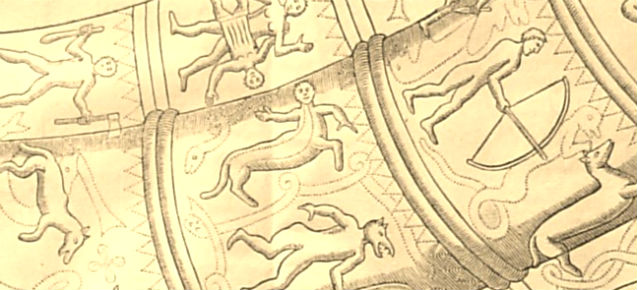Around 400 years into the Common Era, a goldsmith made two beautiful horns, one longer, one shorter. Maybe they were to sound, maybe to drink out of, maybe just as trophies or knick-knacks intended to celebrate an occasion. Bengt Hemtun has a theory that the horns were made to commemorate a treaty between the Angles and the Jutes. They are decorated with Pagan and Roman ideographs. Runes on the shorter one say, "I Lægæst, son of Holt, made the horn." Here, take a look at these beauties:

(Click the image to visit the source page, and higher resolution versions, at Wikipedia.)
So then they were lost, until 1639, when the larger one was found buried in a field by a girl in Gallehus, Denmark, just north of the border with Germany. Admirably, she alerted the authorities. King Christian IV gave it to his son, also named Christian, a hard-partying sort who used it as a wine goblet. He put his initials on it (C5), assuming he would become Christian V when his dad died. But in fact, his partying caught up to him, and he died of a seizure before his dad, so he never did get to be C5. Many years later, the "C5" confused scholars, because an engraving of the horn was published before the real Christian the Fifth was even born!
In the 1640s, poems were written about the larger horn, linking it to Danish sovereignty. In 1734, the shorter horn was found near where the first was discovered, again capturing the public imagination. Together, the two horns were treasured and kept safe in the Royal Art Museum. Their antiquity and great value were well understood. A cast of the horns was made in plaster and sent to a Borgia cardinal in Italy. Another cast was sent to a professor in Dresden. An engraving was made of the larger one in 1643, and others were made later of both. A well-known romantic wrote a famous poem about them.
Here's that engraved illustration of the larger one, from 1643:

(Click the image to visit the source image, at a higher resolution.)
But the casts sent to Italy sank in a shipwreck, and the casts sent to Dresden were lost. And worst of all, a forger and goldsmith stole them from the museum and melted these two unique treasures down! He used the gold to make earings and fake coins to sell, but he was stupid and was caught right away. So the photo above is not really the horns at all. Those are replicas made from engravings. What's more, the replicas were themselves stolen twice, in 1993 and in 2007!
Anyway, from the printed engravings of the originals, we have a pretty good idea of the fantastical sigils, creatures, and monsters that were on the horn. And yes, a taur on each horn. Here are images representing the Golden Horn taurs, from the recreations, engravings, and sketches.



Of course, one wonders ... are these liontaurs? They are identified as "centaurs" on the museum site, but often liontaurs are so misidentified by uneducated curators -- they are no guide.
So we are left to make our own deductions. The tails are long and cat-like, so there is that. The hind legs look a little horsey? So there is that too ... Well, let's take a closer look at that illustration from 1643. Compare the taur to the rider on a horse:

If the taur truly is an equine centaur, why does the horse have hooves, but the taur does not? Why does the taur have a cat-like tail, different from the horse? Centaur or Liontaur? Seems clear that it is more likely a liontaur than a centaur!